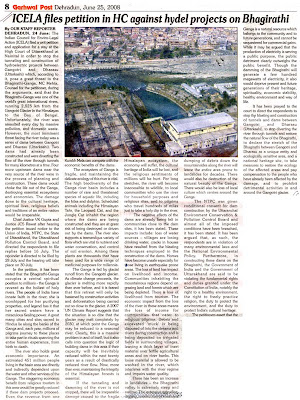Dr G.D. Agrawal, the doyen of environmental engineers in India
[1], has been on a fast-unto-death from June 13, 2008 demanding that River Bhagirathi Ganga be allowed to flow in its natural, unrestricted form, from Gangotri to Dharasu. Ultimately, six dams or barrages will be built on this stretch of the river. These are (see map):
(1) Bhairon Ghati I (380MW): still in the planning stage.
(2) Bhairon Ghati II (65 MW): also in the planning stage.
(3) Loharinag-Pala (600 MW): NTPC began construction over 2 years ago. A road, a tunnel and a residential colony are under construction.
(4) Pala-Maneri (480 MW): construction work inaugurated on June 11, 2008.
(5) Maneri-Bhali I (90 MW): a barrage built in the 1970s.
(6) Maneri-Bhali II (304 MW): a barrage inaugurated in May 2008.
Once these structures are completed, River Bhagirathi will flow in tunnels over half the stretch from Gangotri to Dharasu.
Dr G.D. Agrawal has asked for a legally valid guarantee from the Prime Minister of India that none of the above structures would be constructed or operational (MB I & II). In response, the Chief Minister of Uttarakhand, Shri B.C. Khanduri, has let it be known through his intermediaries and the press that he is willing to drop Bhairon Ghati I and II and the Pala Maneri dams, for which the Government of India should compensate the state of Uttarakhand. He has also said that for the cancellation of the Loharinag-Pala dam, Dr Agrawal should shift his fast to New Delhi and take his demand to the Government of India.
Dr Agrawal has bluntly rejected this 'offer' of the Chief Minister and has reiterated that:
(1) The conditionality of compensation for canceling the BG I & II and Pala-Maneri projects from the GoI is irrelevant to Dr Agrawal. (The Chief Minister should cancel all the projects first and if he wants the state to be compensated he can demand that separately from the GoI. (He should not make the compensation issue a condition for Dr Agrawal.)
(2) The MB-I & II barrages should be decommissioned by permanently opening all their gates.
(3) The CM should immediately order the stoppage of all the work on the Loharinag-Pala project.
Dr Agrawal has told Shri Khanduri's intermediaries that once he has a firm, legally beinding, commitment from the CM of Uttarakhand to cancel the BG I & II and Pala-Maneri projects and to decommission MB I & II, he is willing to consider taking his demand for the cancellation of the Loharinag-Pala dam to New Delhi.
In a strongly worded statement on June 18, 2008 Dr Agrawal has expressed his contempt for senior BJP Leaders like Murli Manohar Joshi and B.C. Khanduri, Shri Ashok Singhal's machinations and the meeting convened by Baba Ramdev and others.
In the meantime, Dr G.D. Agrawal's firm stand continues to receive strong support from scientists, professionals and common people as evidenced by the signatures on an online petition, sympathy fasts, dharnas and signature campaigns across the country and the steady stream of visitors in Uttarkashi. On June 18, 2008 Jagadguru Swami Swaroopanand, Shankaracharya of Dwarka Peeth, has also appealed to the Prime Minister of India and the Chairperson of the UPA to heed Dr. Agrawal's call.
_______________________
Dear Anil,I had shared the background with you and others on this list because you has certified them as a select group of friends. I hope the information remains within the group. But I may be wrong because already two people outside the list have asked me about what your first email means. I do hope your 'selection' has been appropriate and discreet.As for any discussion, all we have so far is a response from Soumya which does not really throw any further light of what could be a strategy - particularly in view of whatever may be the "presence of long standing people's struggles" . (Also, I might add that the remark about "low local participation" may not be fully correct.)WarmlyDunu
On Tue, Jun 17, 2008 at 2:51 PM, anil sadgopal <
anilsadgopal@yahoo.com> wrote:
[1] A civil engineer from IIT-Roorkee, Dr Agrawal did his Ph.D. from the University of California at Berkeley. He was the Head of the Department of Civil & Environmental Engineering at IIT-Kanpur. In the early 1980s he became the first Member-Secretary of India's central Pollution Control Board, where he established the pollution regulatory structure and guidelines for the whole country.




